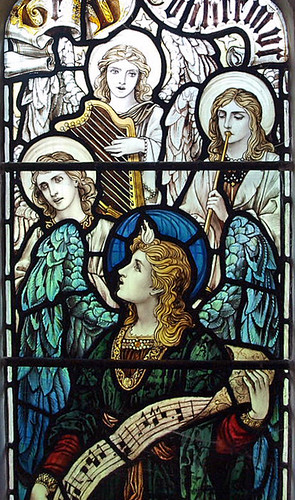ST PETER. Almost entirely of 1851. Tower 1871, spire 1875. The chancel arch with responds of three grouped shafts and double-chamfered arch looks original C14.
PAPWORTH EVERARD. Its white walls lie along the Ermine Street of Roman Britain, but the fame of Papworth belongs to our own 20th century, for the white walls are those of a little world apart, where hundreds of men and women are fighting adversity, busy with a multitude of things by which they hold their own.
Here there is little of the 14th century now left - two doorways, the plain font, and the chancel arch on its clustered columns; for the rest, the church (which has a short spire) is yet a long way off from being a centenarian, but even when the young church has reached old age Papworth will be remembered for the part it has played in the health and well-being of our people.
This place in the green heart of Cambridgeshire is the self-supporting colony of hundreds of people with tuberculosis, the low buildings of their hospitals and the sanatorium are set in lawns and gardens on the hillside with a church among the trees on the ridge looking down on it all. In its short life Papworth has stored up a record of man’s helpfulness to man as glorious as that of any ancient foundation. It is the model village for receiving men and women afflicted with the white scourge of tuberculosis. It contains within itself their homes, their hostels, their hospital, their sanatorium. It sustains them in their illness, it gives new life to them, new faith, new hope, and its mainspring is charity. From its modest beginnings the Papworth Village Settlement has risen to the height of a national undertaking.
Papworth is a barrier against the spread of tuberculosis. When the patient can leave the hospital here he does not go back to a life and work where he is almost certain to relapse. As his health begins to improve he is trained by gradual stages for one of the 11 trades which form Papworth industries. No workshops in the world are more cheerful than these. When he is yet more fit the patient may take his place as one of Papworth’s permanent workers or settlers, the quality of whose handicraft the outside world has had opportunity to appreciate. They will do printing for you, or write your signs, or make you a travelling trunk or a portable building.
One of the best testimonies to Papworth is its appearance, trim and spick and span and newly built from end to end; but a stranger coming on it unawares would never know it for what it is. He might take it for some model village built by a philanthropic and far-seeing manufacturing firm for its working folk. He would see a playground full of children at play, and would find a swimming-pool. Among the trees and gardens he would discover bright modern cottages. The hostels would be quite in keeping.
A number of chalets in a tree-shaded row would be the first thing to give him pause. What are they for? They are the open-air bedrooms for the patients when they first come to Papworth. They are part of the cure the hospital begins. But all the rest that the visitor sees are the progressive steps upward from them: workrooms where trades are learned and practised, separate hostels for the unmarried workers of both sexes, cottages where the married workers live with their families. It is one of the highest tributes to the efficacy of the Papworth system that no child born there while a member of the community has contracted tuberculosis.
Here there is little of the 14th century now left - two doorways, the plain font, and the chancel arch on its clustered columns; for the rest, the church (which has a short spire) is yet a long way off from being a centenarian, but even when the young church has reached old age Papworth will be remembered for the part it has played in the health and well-being of our people.
This place in the green heart of Cambridgeshire is the self-supporting colony of hundreds of people with tuberculosis, the low buildings of their hospitals and the sanatorium are set in lawns and gardens on the hillside with a church among the trees on the ridge looking down on it all. In its short life Papworth has stored up a record of man’s helpfulness to man as glorious as that of any ancient foundation. It is the model village for receiving men and women afflicted with the white scourge of tuberculosis. It contains within itself their homes, their hostels, their hospital, their sanatorium. It sustains them in their illness, it gives new life to them, new faith, new hope, and its mainspring is charity. From its modest beginnings the Papworth Village Settlement has risen to the height of a national undertaking.
Papworth is a barrier against the spread of tuberculosis. When the patient can leave the hospital here he does not go back to a life and work where he is almost certain to relapse. As his health begins to improve he is trained by gradual stages for one of the 11 trades which form Papworth industries. No workshops in the world are more cheerful than these. When he is yet more fit the patient may take his place as one of Papworth’s permanent workers or settlers, the quality of whose handicraft the outside world has had opportunity to appreciate. They will do printing for you, or write your signs, or make you a travelling trunk or a portable building.
One of the best testimonies to Papworth is its appearance, trim and spick and span and newly built from end to end; but a stranger coming on it unawares would never know it for what it is. He might take it for some model village built by a philanthropic and far-seeing manufacturing firm for its working folk. He would see a playground full of children at play, and would find a swimming-pool. Among the trees and gardens he would discover bright modern cottages. The hostels would be quite in keeping.
A number of chalets in a tree-shaded row would be the first thing to give him pause. What are they for? They are the open-air bedrooms for the patients when they first come to Papworth. They are part of the cure the hospital begins. But all the rest that the visitor sees are the progressive steps upward from them: workrooms where trades are learned and practised, separate hostels for the unmarried workers of both sexes, cottages where the married workers live with their families. It is one of the highest tributes to the efficacy of the Papworth system that no child born there while a member of the community has contracted tuberculosis.


No comments:
Post a Comment